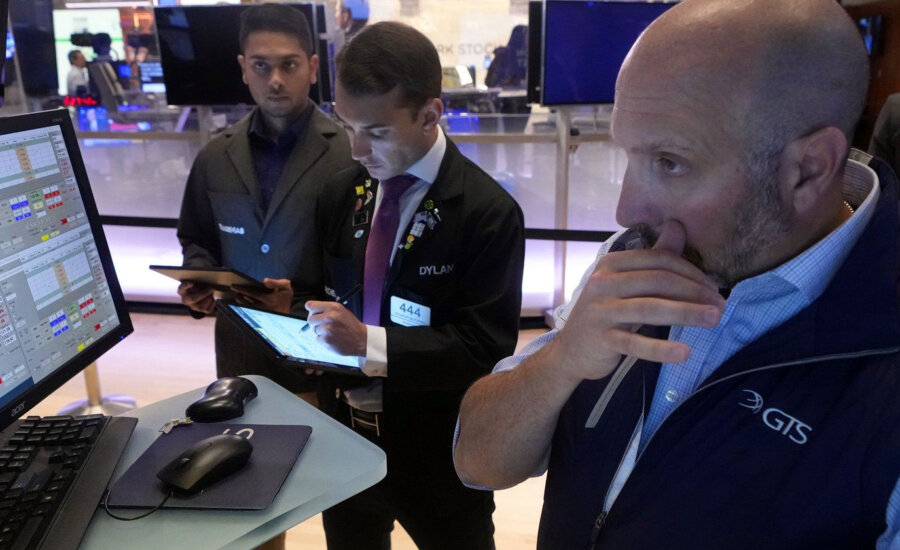Why did the stock markets fall?
Financial markets around the world stabilize after Monday’s fall. Here’s what to know about how we got here.
Advertisement
Financial markets around the world stabilize after Monday’s fall. Here’s what to know about how we got here.

Markets on Wall Street and in Asia are stabilizing Tuesday following a mini-panic caused by an assortment of factors that stretched from late last week through Monday.
The S&P 500 and Nasdaq each rose 1.3% in morning trading and were on track to break a brutal three-day losing streak. The S&P 500 had tumbled more than 6% after several weaker-than-expected reports raised concerns that the U.S. Federal Reserve had pumped the brakes too much on the U.S. economy through high interest rates. The Dow Jones Industrial Average was up 0.7%.
Elsewhere, Japan’s Nikkei 225 jumped 10.2% Tuesday, following its 12.4% sell-off the day before, which was its worst since 1987. Stocks in Tokyo rebounded as the value of the Japanese yen stabilized a bit against the U.S. dollar following several days of sharp gains.
A rate hike last week by the Bank of Japan contributed to the turmoil by upending trades where investors had borrowed Japanese yen at low cost and invested it elsewhere around the world. The resulting exits from those investments may have helped accelerate the declines in global markets.
Starting Thursday, investors grew worried about a slowing U.S. economy. They pointed fingers at the U.S. Fed for waiting too long to cut rates and sold shares of technology companies that had ridden a frenzy around artificial intelligence to lofty stock market valuations.
Calmer voices that claimed the sell-off was a good thing because stock prices had risen too high seemed to prevail Tuesday. Some of Tuesday’s gainers were those same technology companies investors had fled from. Chipmaker Nvidia was up 3.8% Tuesday morning, following a drop of 6.4% on Monday.

Provide a 30-day notice before withdrawing your cash and earn 5% (or 4.5% when you provide 10-day notice).

Lock in your deposit for one year and earn a guaranteed interest rate of 4.85%.

$0 commission on all online stock transactions. No minimum deposit needed.
MoneySense is an award-winning magazine, helping Canadians navigate money matters since 1999. Our editorial team of trained journalists works closely with leading personal finance experts in Canada. To help you find the best financial products, we compare the offerings from over 12 major institutions, including banks, credit unions and card issuers. Learn more about our advertising and trusted partners.
For individual investors, it’s not time for rash decisions, but a moment to make sure their investments are properly diversified, experts say.
Here’s a look at what’s driving the turbulence in markets:
Starting in 2022, the U.S. Fed rapidly raised interest rates to combat a spike in inflation. It’s maintained its key rate at 5.4% for about a year. As part of its inflation fight, the U.S. Fed also aimed to cool down a red-hot labor market.
Investors thought the U.S. Fed and other central banks were on track, even though inflation remained somewhat above their targets—in the U.S. Fed’s case, 2%. The European Central Bank and the Bank of England cut rates once and the Fed signalled it was prepared to start cutting rates in September.
Despite some signs of cooling, the U.S. economy kept chugging along even with higher rates, outpacing Europe and Asia. Then came last week’s economic reports.
Weak reports on manufacturing and construction were followed by the government’s monthly report on the job market, which showed a significant slowdown in hiring by U.S. employers. Worries that the U.S. Fed may have kept the brakes on the economy too long spread through the markets.
A handful of Big Tech stocks drove the market’s double-digit gains into July. But their momentum turned last month on worries investors had taken their prices too high and expectations for their profit gains had grown too difficult to meet—a notion that gained credence when the group’s latest earnings reports were mostly underwhelming.
Apple fell more than 5% Monday, after Warren Buffett’s Berkshire Hathaway disclosed that it had slashed its ownership stake in the iPhone maker. Nvidia lost more than $420 billion in market value Thursday through Monday. Overall, the tech sector of the S&P 500 was the biggest drag on the market Monday.
The Nikkei suffered its worst two-day decline ever, dropping 18.2% on Friday and Monday combined. One catalyst for the outsized move has been an interest rate hike by the Bank of Japan last week.
The BoJ’s rate increase affected what are known as carry trades. That’s when investors borrow money from a country with low interest rates and a relatively weak currency, like Japan, and invest those funds in places that will yield a high return. The higher interest rates, plus a stronger Japanese yen, may have forced investors to sell stocks to repay those loans.
A carry trade is a strategy used by bond traders, currency traders and others hoping to profit from differences in interest rates.
Imagine you’re a kid, and you borrow $5 from your mom to loan it to your brother and charge him $2 interest. That’s similar to a carry trade. When short-term rates are lower than longer-term rates, a bond trader can borrow at the lower short-term rate and invest the proceeds at the higher long-term rate. Similarly, a currency trader can borrow currency in a country with low interest rates and invest the money in another country, where rates are higher and attractive investment returns are expected.
Read “What is a carry trade?” from the MoneySense Glossary.
The prevailing wisdom is: Hold steady. Experts and analysts encourage taking a long view, especially for investors concerned about retirement savings. “More often than not, panic selling on a red day is generally a great way to lose more money than you save,” said Jacob Channel, senior economist for LendingTree, who reminds investors that markets have recovered from worse sell-offs than the current one.
Bitcoin was back up to $56,490 Monday morning after the price of the world’s largest cryptocurrency fell to just above $54,000 during Monday’s rout. That’s still down from nearly $68,000 one week ago, per data from CoinMarketCap.
While bitcoin did serve as a safe haven of sorts during the worst of the pandemic, it mostly acts like any another risky asset that investors steer clear from during market downturns.
Greg McBride, financial analyst for Bankrate, points out that a 10% pullback in markets happens on average once every 12 months. The S&P 500 is down about 8.5% from its recent high.
Chris Zaccarelli, chief investment officer for Independent Advisor Alliance, says investors should wait to see how the recent turbulence plays out. “It remains to be seen whether this recent weakness in the labour market is the canary in the coal mine (in which case the selling is justified) or if it is just a temporary cooling of the job market (in which case this will prove to be another buying opportunity),” he wrote in a note to clients Monday.
Share this article Share on Facebook Share on Twitter Share on Linkedin Share on Reddit Share on Email